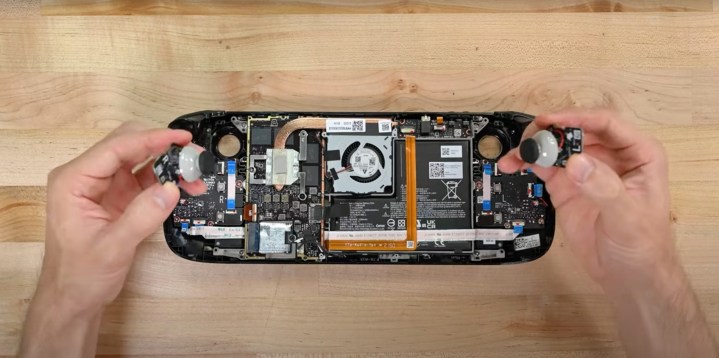After nearly six months since my original review of the Asus ROG Ally Z1 Extreme, the device has undergone significant changes. While it still outperforms the Steam Deck in raw performance, a series of unusual updates have put the ROG Ally in a peculiar position compared to its competitor.
For those unfamiliar with handheld gaming PCs, the ROG Ally still excels over the Steam Deck. However, as outlined in our Steam Deck review, Valve’s handheld continues to make waves in the world of gaming handhelds despite its aging hardware.
Price Plays a Key Role

Price has been a significant point of contention for the ROG Ally, especially when compared to the competitively priced Steam Deck. However, Asus has responded with equally aggressive pricing to challenge Valve’s handheld.
The ROG Ally with the Z1 Extreme is priced at $700, exclusively available at Best Buy. Despite initial concerns about it selling out quickly, it is still in stock. A more affordable model featuring the Ryzen Z1 is also available for $600.
On the other hand, the Steam Deck starts at $349, but that’s for the 64GB variant with slower storage. To match the 512GB storage capacity of the ROG Ally with the Z1 Extreme, you’ll need to spend $449. Valve also offers refurbished Steam Decks, driving prices down to $279.
Valve is phasing out the 64GB and 512GB models in favor of the new Steam Deck OLED. The 256GB model is now priced at $399, with the Steam Deck OLED available in 512GB for $549 and 1TB for $649. While the ROG Ally offers superior performance, it also comes with a significantly higher price tag.
Specialized Specs

While the ROG Ally boasts an attractive design, its standout feature is the underlying hardware. Powered by AMD’s Z1 Series processors, custom APUs with Zen 4 CPU cores and RDNA 3 GPU cores, the ROG Ally offers two distinct configurations.
The Ryzen Z1 features six Zen 4 cores and four RDNA 3 cores, providing up to 2.8 TFLOPS of theoretical performance. In contrast, the Ryzen Z1 Extreme comes with eight Zen 4 cores and 12 RDNA 3 cores, delivering unparalleled performance of up to 8.6 TFLOPs.
While the ROG Ally was the first to introduce the Z1 Extreme, it now faces competition from Lenovo’s Legion Go and the Ayaneo 2S, each equipped with similar processors.

Comparatively, the Steam Deck features weaker hardware with four Zen 2 cores and eight RDNA 2 cores offering up to 1.6 TFLOPs of theoretical performance. The Steam Deck’s APU caps at 15 watts, while the ROG Ally can reach up to 30W in Turbo mode.
Despite the disparity in APUs, both devices share similarities such as 16GB of LPDDR5 memory, a Micro SD card slot for storage expansion, support for USB-C charging, and a 3.5mm headphone jack. However, ASUS has acknowledged issues with the Micro SD card potentially failing under specific thermal conditions.
Performance Leader

The ROG Ally with the Z1 Extreme clearly outpaces the Steam Deck in performance. With comparable settings and wattage, the ROG Ally surpasses the Steam Deck by over 50%. Despite recent updates impacting performance, the ROG Ally remains a strong contender.
While the ROG Ally offers higher performance, it also faces challenges with updates affecting its stability. Additionally, the device’s battery life varies based on performance modes, with Turbo mode draining the battery significantly faster.
Ultimately, the ROG Ally presents a superior option for gaming on-the-go, providing enhanced performance and visuals compared to the Steam Deck. However, users should consider usability and potential drawbacks before making a decision.
Superiority in Features

While the ROG Ally presents some drawbacks, it offers improvements over the Steam Deck in terms of performance, game support through Xbox Game Pass, and display quality. However, this superiority is mainly evident in the flagship Z1 Extreme model.
For users considering the base model with the Ryzen Z1, the Steam Deck may be a more suitable option. The Steam Deck continues to impress with stability and overall performance, making it a preferred choice for existing handheld gaming PC users.
Windows 11 Integration

One significant distinction between the ROG Ally and Steam Deck is the operating system. While the Steam Deck utilizes Valve’s SteamOS, the ROG Ally integrates Windows 11.
Both operating systems offer unique advantages and drawbacks, with SteamOS providing a streamlined interface tailored for gaming but limited compatibility with certain games. Windows 11, on the other hand, offers broader game support and functionality but may lack the optimized handheld experience of SteamOS.
Despite these differences, the choice between the ROG Ally and Steam Deck ultimately depends on personal preferences and specific gaming needs.
Conclusion
In conclusion, the Asus ROG Ally Z1 Extreme emerges as a formidable competitor to the Steam Deck, offering superior performance, enhanced game support, and a more versatile operating system. However, users should carefully weigh the device’s advantages against its drawbacks and consider their individual gaming priorities before making a decision.
Frequently Asked Questions
Is Upgrading from Steam Deck to ROG Ally Worth It?
Based on our analysis, upgrading from a Steam Deck to a ROG Ally may not be advisable due to recent performance fluctuations in the ROG Ally. Users should consider the potential trade-offs before making a decision.
What is the Cost of the ROG Ally?
The ROG Ally with Z1 Extreme is priced at $700 but may be available at a discounted rate of $600 at select retailers. The base model with Ryzen Z1 is priced at $600 but currently retailing for $400.
What is the Battery Life of the Asus ROG Ally?
During our testing, we observed varying battery life for the Asus ROG Ally with Z1 Extreme:
- Up to five hours in Silent mode (less demanding game)
- One hour in Turbo mode
- Up to two hours in Performance mode (demanding game)



